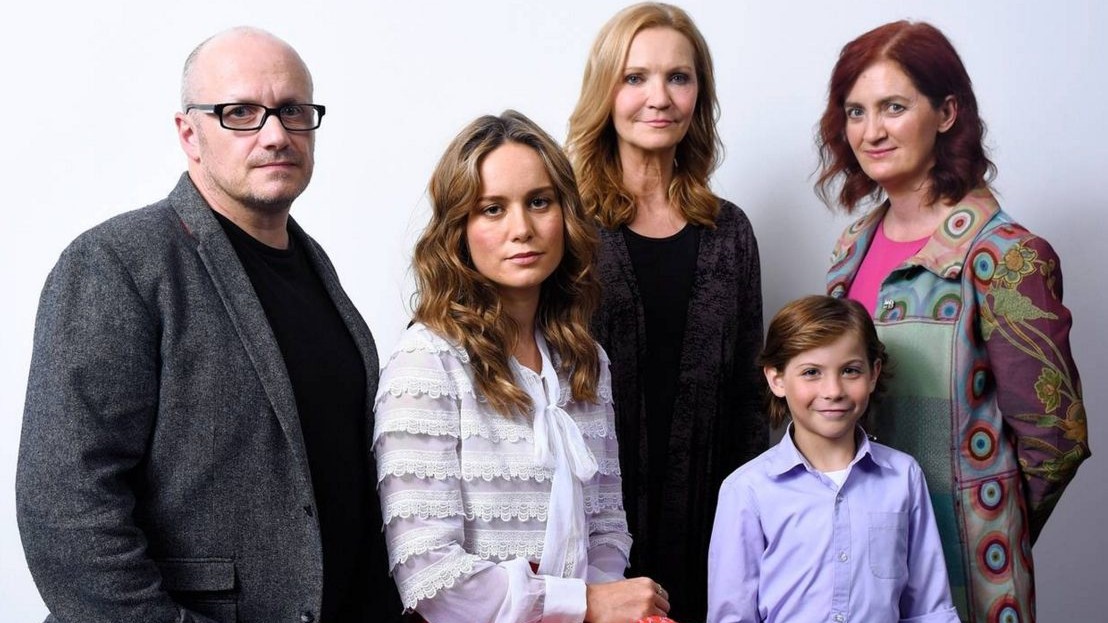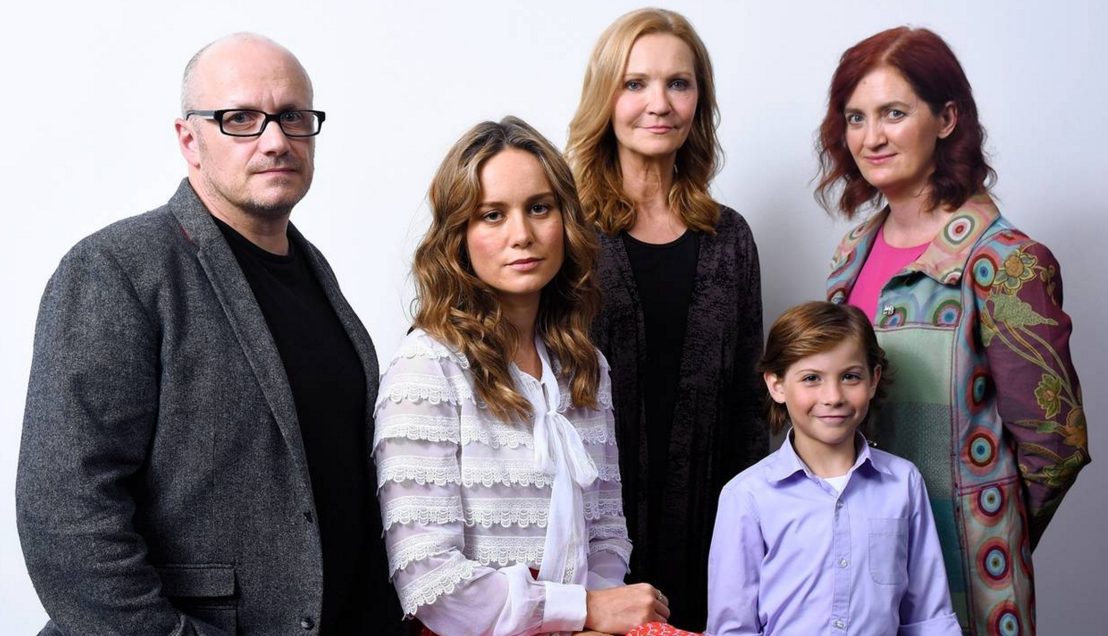26-year-old Brie Larson makes her way to her seat in the Orchard room of the Four Seasons Hotel looking every part the “seriously popular” girl she’s been referred to, and nothing like her disheveled character, Ma. In a light blue, bell-sleeve blouse and flared jeans, her only similarity to Ma is the undeniable love and admiration for her 9-year-old co-star, Jacob Tremblay, whom she helps get settled in and comfortable before our interview starts. As everyone takes their seats, we are reminded that we could very well be talking to a group of people who may be particularly busy come this awards season. From left to right sits the director Lenny Abrahamson, Joan Allen, Larson, Tremblay and author/screenwriter Emma Donoghue. While Jacob steals the scene with his honest answers, things get serious when we talk about the mystery of putting a face to these fictional characters, the dark places Brie went offscreen to get into character, and how acting is really only “playing”. We begin:
Jacob, was it hard for you to get into character?
Jacob Tremblay: It was actually not that hard because it was mostly a playing movie where I played a lot. I play a little kid that’s kind of like, ‘eh, whatever’. [The hardest part] was wearing an itchy wig.
Emma Donoghue: I’m sorry about the wig, that one’s on me.
Laughter
Emma, what was it like adapting your own novel for the screen? How precious were you with the original text?
Emma Donoghue: I relished the opportunity because cinema has different techniques, it offers different pleasures. One thing I love are the ways in which the film is different from the book. There are so many moments when you’re looking at Jacob’s face onscreen and you don’t know what’s going through his mind and I love the unspelled nature of that. In the book, you know exactly what they’re thinking. I love the way they brought the character to physical life and that you get equal access to both Ma and Jack in the film. In many ways, that’s a huge improvement from the book.

There were two completely different points of view, you capture Ma’s perspective of being more claustrophobic and the openness of what Jack sees. How did you design this visual tone inside Room?
Lenny Abrahamson: That was probably both the most challenging and exhilarating part of making this film, to hold on to that capacity to operate inside Jack’s magical sense of this space as a place that, as he says at one point in the film, “Went all the way to the end”. On the other hand, we’re looking at this grimy single room location. [My cinematographer] Danny Cohen and I found ways to move in and out of Jack’s point of view subtly- we didn’t want big stylistic marks because I think that would undermine the believability and intimacy of the encounter with the characters.
What were your thoughts when you first received the script?
Lenny Abrahamson: I read the novel first, I didn’t know Emma had very sneakily written a script before she even published the novel. So I read the novel, fell in love with it and had very strong ideas about how we might translate one into the other. I wrote Emma a long letter that said the things I thought were special about the book, and luckily there was synergy in what Emma and I were both thinking about the script.
Brie Larson: I had read the book maybe a year prior and one of the mysteries was Ma because she is seen through Jack’s eyes, and so she’s a saint, she’s so ethereal and sort of faceless. I was very curious when I heard it was being made into a movie as to who that face would be, and I never pictured it would be my face.
For our review of Room, click here.
Brie Larson: The thing that I was so drawn to was the myth that was there. This is not just some story about some sort of crime tale, this was Plato’s cave, this was Rapunzel, Bluebeard, Demeter & Persephone- it is all of these reference points that I loved so much. I was lucky that when I sat down to meet with Lenny, he understood it in the same way that I did and was interested in exploring the same aspect of taking a story we’ve all seen on the news and making this a real universal story about love and growing up, and the beauty of living in a small space as a child. There are some aspects of it that are so beautiful and so nice to not see the darkness but on the other hand, there is a whole range of experiences that are being missed because of it.

Did playing Ma ever become an emotional taxing experience for you?
Brie Larson: Over the course of the seven months I spent prepping and filling my brain with everything that was “her,” I was really changing the neurological patterns of my brain so that by the time we hit set and we’re shooting, I don’t have to think about my wrist hurting or the lack of vitamin D. It becomes so ingrained in you that you just know it. Because of that, you have to be quite gentle with yourself and very understanding that you are just being a vessel for somebody. It’s important to allow yourself to go down the road of being that vessel but having a very clear understanding that it’s not you. I would even go so far as to take a piece of paper and draw a line down the center of it and write “Brie” and “Ma” at the top and just list all the things that were me and all the things that were her. So in those moments when I’m at lunch like, “I feel like no one understands me,” it’s like nope, that’s Ma, that’s not me.
What were some of the ways you got into character?
Brie Larson: I wrote three journals. I also stayed at home for a month. I imagined there was a lot of time for her to reflect and magnify and to create a fantasy as to what her past was. I had some amazing conversations with my mom and I’m of the age now where a lot of my friends are having children of their own and getting to speak with them about this turn that happens, where suddenly there’s no time to wallow. Your heart grows three sizes and suddenly there’s this thing you have to love, nurture, and protect, yet at the same time try and explain what the world is.
Jacob Tremblay: I was shy at first, but then I wasn’t shy because my mom had this idea that Brie should come over and we could get to know each other a little bit more. So that happened, and then we became friends.

Brie and Joan, you spent so much time with Jacob on screen, how did that enhance your performance?
Joan Allen: It reminded me to stay open and curious. Acting is childlike in some ways, you’re pretending. Sometimes you can have a tendency to overthink things and that doesn’t look as natural. It was very inspiring to work with Jake who is very present and in the moment.
Brie Larson: Yeah, you remember there’s this sense of play and ease to all of it, and that although we are telling a story that has some delicate and dark material, it’s not one that we really need to dip that far into. The same way that he brings this perspective of innocence and light to the movie is exactly what he brought on set. Like when we did our reunion scene- I’m banging on the police car door and I’m crying and holding him and they yell cut, I remember Jacob pushing me off of him going, ‘I don’t get it, you just saw me 10 minutes ago.’
The television was an amazing prop, it added so much depth to that little room.
Emma Donoghue: When I was writing the book I sweated over whether they should have a television or not. I knew they couldn’t be fully connected but I thought if they didn’t have TV is would be like 19th-century life and it’s not that I wanted their world to be pre-modern, I just wanted it to be isolated. Once Jack starts asking those questions [of reality] and Ma gives him answers, the TV does become a way for Jack to figure out how Room fits into the wider world. I was particularly happy when we got a fan letter from the creator of “Dora the Explorer” who was delighted that Jack never renounces Dora. Even in the second half Jack is still loyal to Dora.
Lenny Abrahamson: The transition from the inside to the outside world would have been entirely different without the existence of TV.

How did you prepare for such dramatic roles?
Brie Larson: How is started was trying to understand those two years of basic silence of being alone in this place [before Jack was born]. I meditate, so I was a little familiar with trying to get to mental silence and how hard that is. I had some friends who had been on silent retreats and I was fascinated by their reactions. Some of them could go 10 days, but I had other friends that couldn’t last 24 hours. There was this sense of sitting with yourself and imagining Ma at 17, 18, 19-years old the way most teenagers don’t. There were moments I had remembered of my childhood that were so beautiful and other moments that I had completely forgotten that were painful.
Joan Allen: I had done some readings about abductions. Jaycee Dugard’s mother Terry Probyn had some Youtube footage of what was like to be reunited. She said it was a very difficult thing to reunify and you need a lot of help in the way you do it. I’m also the mother of a 21-year-old so I’ve been sufficiently scared by various choices she’s made in her life.
Laughter
Most films shoot out of order for practical reasons, but I’m assuming you shot all of the room first and then the outside world later?
Lenny Abrahamson: The decision was made very early on that we would shoot as far as possible in sequence. Shooting the room sequence first wasn’t practically the easiest thing to do because we shot in Toronto coming into winter and it would have made a hell of a lot of sense to get the exteriors out of the way while the weather was still ok, and then when the temperature hit -15 to get inside a nice, cozy studio. Also for Jacob’s sake- that was the original reason. It would be a lot easier for Jacob if the story unfolded naturally. It’s tough enough, his role is already difficult so shooting in sequence really helped. I think all of us, in the end, found it a wonderful way to work. It’s going to be really hard to go back to the traditional way of working.
Morgan Rojas
Certified fresh. For disclosure purposes, Morgan currently runs PR at PRETTYBIRD and Ventureland.


